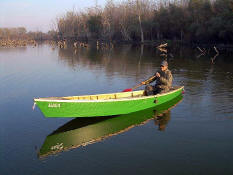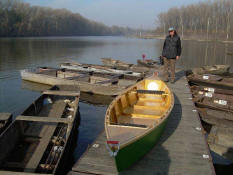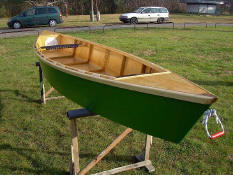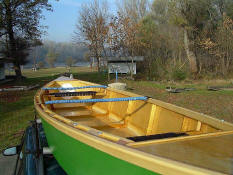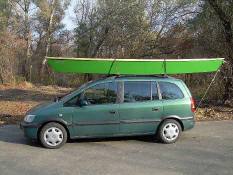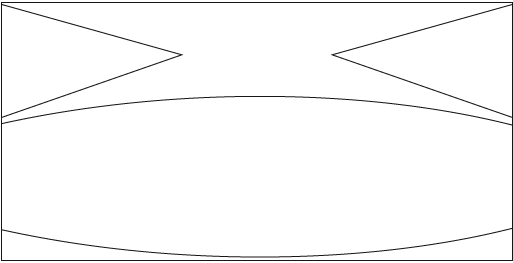|
Dear Uncle John,
I have finished my pirogue, based on your plans. I did not take the cost
and trouble to order your kit from the overseas. On the other hand, I
wanted to scale up the boat, so the rib set, and stems would have been
useless to buy. Although I came across some
pirogue plans here and there around the net, I found yours the most
practical, most detailed, and definitely the clearest! Thank you for
making public that bunch of quality information!
I made my pirogue from 6.5 mm (1/4") birch plywood. Size of sheet was 2,5
m x 1,25 m, so a bit larger, than the standard 8' x 4'. One sheet was
ripped up for the sides, another is for the bottom. I modified the layout
of the bottom, in order to maximize the width. You might remember me: I
was the guy, who asked you about the diagonal cut of the bottom panel, for
a more economical layout. You advised me to avoid this way, as the grain
orientation of the plywood may cause troubles. Finally I figured out
another way (see the drawing below). This way I
was able to achieve 80 cm (32") bottom width, so that the boat is stable
enough to stand up in, when fishing. I believe that there is another
advantage of my arrangement. This way the widest, and most exposed part of
the bottom is made from one piece. The bottom joints are far from the
center, and not in line with the side joints. Probably it's not a big
issue, but it's enough for me to believe so :-)
I was a bit afraid, but managed to scarf the plywood pieces successfully,
according to your method. Though if I have done it again, I'd rather use
glassed butt joint. I tried this method on scrap pieces later, the
simplicity and strength was amazing! The stems
and ribs are made of hardwood (robinia), and proved to be pretty heavy. I
could have spared at least 10 lbs, if I made them lighter.
I seamed the chine inside with a 10 cm (4") glass tape, and glassed
the whole bottom outside, folding up the glass on the sides up to 10 cm
(4") height. I didn't want to throw away the leftover pieces of textile,
so that I used them up for reinforcing the bottom inside, after some
puzzle game with them. Although I didn't plan to apply glass inside, it
proved to be useful, as it makes the bottom really solid, and hopefully
will stand for the wear better. The gunwales are
from spruce. The inner rail is not only eye-catching, but proved to be
very practical when handling the boat. It worth the extra work!
I made closed compartments at both ends, for flotation and keeping
my stuff dry. The bare wood surfaces were
treated with linseed oil-turpentine mixture (I liked the smell :-)), and
varnished with 3 layers of boat varnish. The outside is painted with an
oil based fence paint. The seats are woven from strap, on wooden frame.
The whole thing weighs around 100 lbs. Two person can handle it
easily. I feel it a bit "overdone" now, but it's quite sturdy. You know,
the beginners, like me, tend to oversize the things, standing on the safe
side. If I built next time, it could be 80 lbs or so, without sacrificing
the strength and reliability.
I would be happy, if you put my pictures into your gallery.
Thanks a lot again,
Best regards,
Janos Benyhe
Hodmezovasarhely, Hungary
|
